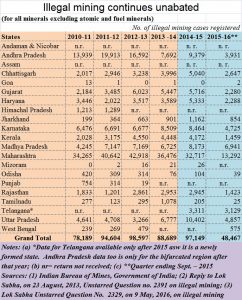Policy Watch: Stop illegal mining before it distorts Indian economy
Illegal mining: It thrived under the UPA; it continue to thrive even today. . .
When the present government came to power, one thought that illegal mining would get throttled. This was because, all along, the common perception was that self-appointed environmental groups agitated against the building of roads, ports, official mines, and railway lines (http://www.asiaconverge.com/2013/05/illegal-mining-and-politics/). That in turn provided illegal miners the protection they needed to carry on their work unhindered.
 After all, there was increasing anecdotal evidence that much of the Naxalite movement had been funded by NGOs. They had effectively allowed illegal mining to flourish. The Naxalites, it was argued, prevented the setting up of legitimate businesses. That in turn reduced the pressure for connecting remote areas with roads, railway lines, police stations, hospitals and schools. Even ports were not spared, as they would necessitate road and rail connectivity. As a result, illegal miners and those who funded them had a field day.
After all, there was increasing anecdotal evidence that much of the Naxalite movement had been funded by NGOs. They had effectively allowed illegal mining to flourish. The Naxalites, it was argued, prevented the setting up of legitimate businesses. That in turn reduced the pressure for connecting remote areas with roads, railway lines, police stations, hospitals and schools. Even ports were not spared, as they would necessitate road and rail connectivity. As a result, illegal miners and those who funded them had a field day.
That illegal mining is immensely profitable cannot be doubted. Consider the notings in diaries of the enforcement directorate relating to the Saradha scam. They reveal that almost Rs.1,000 crore of Saradha’s money had been diverted to finance illegal mining in Meghalaya. Then consider the wealth that the Bellary brothers had amazed. The astounding growth in wealth of the son of a former chief minister too was traced to illegal mining (http://www.asiaconverge.com/2014/05/orissa-illegal-mining-and-supreme-court/).
People expected this illegal activity to get curbed once the new government took charge. First, the activities of many NGOs were severely curbed. Then, there was much emphasis on good governance.
Yet, when it comes to illegal mining, the present government has had as many if not more instances of illegal mining than during the UPA years (see table alongside). And given the numbers during the first quarter of 2015-16, there is a good likelihood of these numbers going up even further.
One would have also thought that, after the political focus on illegal mining in Karnataka, this state would see a reduction in incidents reported. But the opposite appears to have happened. The number of instances of illegal mining registered jumped from 6,476 in 2010-11 to 8,464 in 2013-14. The figures for the first quarter of 2014-15 do not augur well on this front.
Some BJP ruled states like Rajasthan, Madhya Pradesh and Chhatisgarh have also witnessed an increase in illegal mining activity. That does not lend confidence to the claims of good governance.
Some states like Maharashtra do provide cause for cheer. It saw a decline in the number of illegal mining cases registered (http://www.asiaconverge.com/2013/09/maharashtra-tops-in-illegal-mining/). Of course, there is always the possibility that this decline could be due to non-registration of cases — in collusion between the authorities and miner-barons. But it is best to take the numbers at their face value for now.
So, why has illegal mining not reduced? The answer is simple. It is immensely profitable. And since it is illegal, it is also tax-free. It does not matter what the finance minister, Arun Jaitely, might say. If the moolah is large, all parties will learn to collusively accept their little share of this cash-cow. All political parties need money. The proceeds from illegal mining is a very good way to get huge amounts of hard cash.
But there are signs that the administrative machinery is gearing up to fight illegal mining. This can be discerned by looking at the data presented before the Lok Sabha (not reproduced in the table). Watch how the number of cases reported fell from 98,597 (during the period from 2010-11 to 2012-13) to 97,149 (from 2012-13 to the first quarter of 2015-16 ending September 2015).
But more remarkable is the number of FIRs registered which rose from 8,442 to 14,458 during the same periods. Also observe how the number of court cases filed also swelled from 27,636 to 43,091. Evidently, someone is monitoring the situation closely and is trying to ensure that the culprits did not get away merely by paying a token fine as was the case earlier.
But there are some other worrisome signs. Incidents of returns not being received (n.r.) appear to be on the increase. Figures for Goa are not available for recent years. Himachal Pradesh and Assam too are guilty of this lapse. Punjab too has not been providing data on this subject. Even the very names of some north-eastern states – like Meghalaya and Tripura – are missing from these lists. Many of these are states where reports of corruption in high places have been flying fast and thick. The absence of numbers from these quarters is therefore not comforting. This is a disturbing development.
If the government wants to improve rural development, illegal mining must be stomped out. It is illegal miners who do not want good road and rail connectivity to remote areas. Their very isolation allows them to steal mineral (and even forest produce) quite easily. Moreover, it distorts the economy, allowing some people to make pots of money at the cost of national resources. Both damage the economy seriously, and erode the credibility of the government.
This must be curbed, urgently.





































COMMENTS